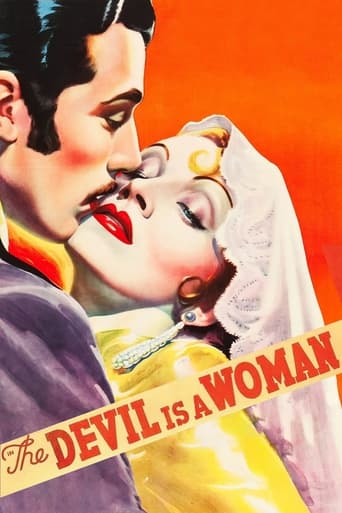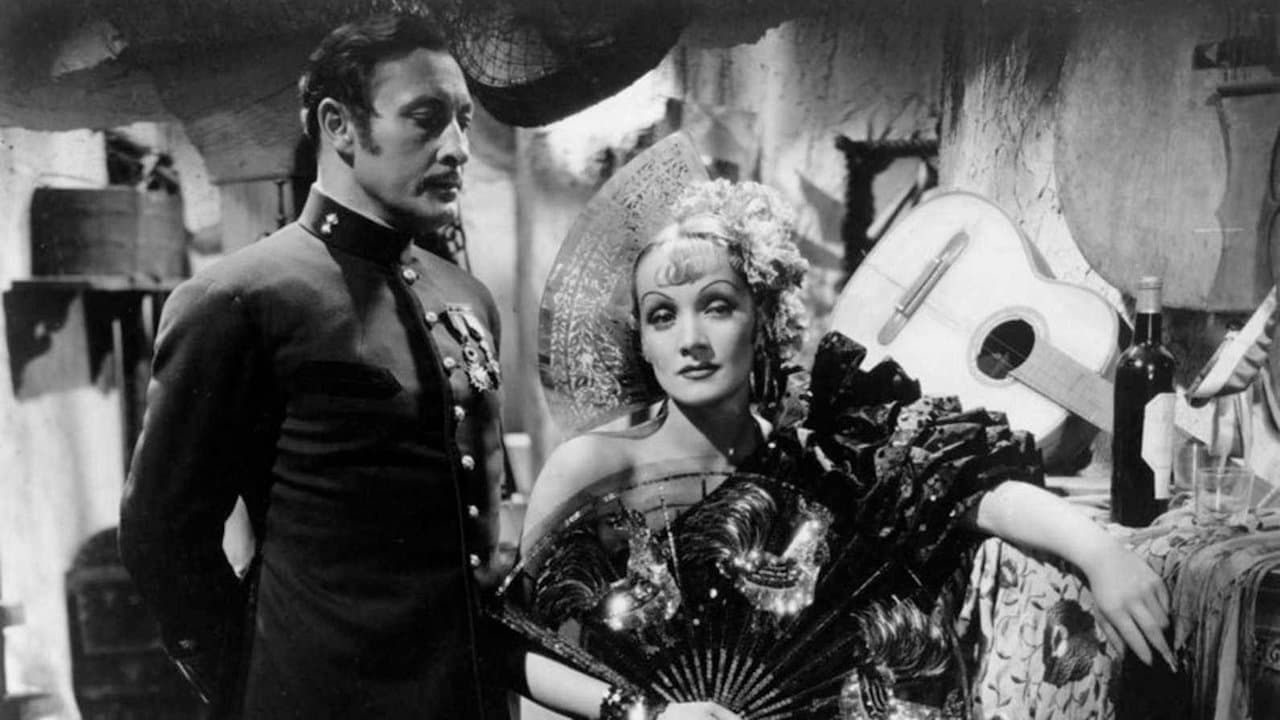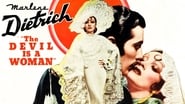chaos-rampant
If you have closely followed Sternberg you could tell this moment was coming. All his films since he joined up with Dietrich were powered by a seductive electricity channeled and discharged back and forth between herself and the camera, but always struggled in some measure to hold back to a recognizable world. The Scarlet Empress just before this was only held back by a thin semblance of history, if that, a history that was utterly bent to his fervent adoration to crown Dietrich queen of Hollywood. It was an unhinged, anguished film, mirrored on every misshapen gargoyle figure, every distorted fresco on the walls of the surreal church.But here he finally lets go and is afforded a kind of tranquility, as if he knew he would lose her after this film and would be lost himself. This would be his last film with Dietrich, and perhaps the last time he mattered. The whole film is an effervescent dream this go round, no pretense about it anymore. Oh, it's supposed to be taking place in Spain, but as much as Empress was taking place in Russia. So a world envisioned as a moonlit walk beneath cedars, a walk a little outside the common maps, with every step masked in the smoke from some opium pipe, veiled shaped and long shadows, at the center faintly humming with the emptiness behind illusions. The premise is that it's the traditional time of the carnival, a week long promise of deceptive sex beckoning from behind masks, inside swirling crowds and confetti rains. Dietrich enters the scene on a lavish chariot like already the queen from the previous film, once again every camera on her, every male pair of eyes transfixed on her eyes promising sweet things.But Sternberg is not just waxing here like a lovestruck bird, for once since a long time. We float in restless sleep but need to stay lucid enough to perceive where the dream is floating from. One source is revealed halfway through, this much is easy to grasp; the man, another lovestruck Sternberg, weaving stories about this reputedly scandalous woman, and how much of it true or merely a ploy to thwart the sexual antagonist? Is she the devil, or is the devil in our lusting eyes?She does behave a lot like we were told she would when we first meet her, sultry, seductive, a sexual being, but it doesn't have to mean anything. So we dream some more, looking to apprehend the face behind the mask.We surface back into the real world, itself resonating with dreamlike ambiance, with no clear demarcation between fiction and truth, for a marvellous scene in a theater where she lets fate deal the cards. The scorned lover takes out a pistol and shoots at the queen of hearts.But beyond the ensuing battle of lovers, beyond even the final twist that sends us away and keeps the camera with her for one last knowing smirk, there is the actual source of the dream that we haven't spotted yet. So a film about a woman who is the subject of stories, a dream about us dreaming her, the woman who is yet present outside the frame but pure and intangible to the last. See if you can spot it out, and if the film is just gaudy, dreamy, or transforms into the makings of that dream. I mean if she is that queen of hearts, then who is shuffling the deck?There is no Eyes Wide Shut without this film, to go this far.There is finally a look of world-weariness that mellows Dietrich's face, a kind of stoic resignation to the cards being dealt as they are, or have been a long time ago. No doubt Welles saw this, many times over, and cast her in Touch of Evil twenty years down the road. Her parting line in that film wonders what does it matter what you say about people. It pertains here.
Claudio Carvalho
In the carnival in Spain in the beginning of the Twentieth Century, the exiled republican Antonio Galvan (Cesar Romero) comes from Paris masquerade to enjoy the party and visit his friend Capt. Don Pasqual 'Pasqualito' Costelar (Lionel Atwill). However, he flirts with the mysterious Concha Perez (Marlene Dietrich) and they schedule to meet each other later. When Antonio meets Pasqualito, his old friend discloses his frustrated relationship with the promiscuous Concha and her greedy mother (Alison Skipworth) and how his life was ruined by his obsession for the beautiful demimondaine. Pasqualito makes Antonio promise that he would not see Concha. However, when Antonio meets Concha, she seduces him and the long friendship between Antonio and Pasqualito is disrupted. "The Devil Is a Woman" is the last movie of director Josef Von Sternberg and Marlene Dietrich together. The romance tells the story of a cold- hearted dancer that has a promiscuous life and is financially supported by her obsessive lover in an unrequited love. The man ruins not only his professional life, but also his long friendship with Antonio. Marlene Dietrich is beautiful in this film and the role seems to be tailored to her. The excellent cinematography in black and white is very impressive. My vote is seven.Title (Brazil): "A Mulher Satânica" ("The Satanic Woman")
satranc12
After having watched The Devil is a Woman innumerable times, I still can't get over my excitement about certain scenes: If you haven't seen the film yet, go for it. If you know it well, re-live the pleasure of it reading these lines.1. Above all: The scene introducing Concha in midst of the carnival crowds and carriages. Her entrance is carefully prepared: First we are we get a glimpse of a somewhat faded Senora flirting from a balcony. The music meanwhile is a cacophony of brash carnival tunes, the images likewise chaotic montage, the screen filled with crowds, balloons, streamers and confetti, the sound and images seem to be cropped and assembled at random.The cacophonic music suddenly changes to trumpet fanfares which announce the arrival of Concha's carriage. The camera pans down from a balcony to the street, following downward hanging white streamers. Concha's white carriage enters from the left, drawn by a pair of white horses, two coachmen in white livery. She is sitting all alone in an ocean of white and presumably pink balloons, wearing her famous black pompom costume with matching head-dress, black lace mask and black lace gloves, underneath nails painted very red, as you can later see when she shakes her finger at Antonio. She's holding to her bosom a huge mass of white carnations which she throws to the admiring crowds. Meanwhile in the foreground, entering from the right, three black carriages drive by, drawn by dark horses, inside several young women who judging by their costumes and behavior obviously haven't Concha's class. The whole scene drowned streamers, balloons, confetti.If this alone doesn't make you hair raise, there is the most erotic, flattering and slightly risqué "Spanish dance music" accompanying Concha's flirtations and close-ups. No harsh carnival tunes for her! The scene is so rich, it must be seen (and heard) many times.2. Another scene which gains immensely by the music. It's not Rimski or Falla, Sternberg must have dug up a lot of traditional Spanish music which I can't identify being no expert, sorry. Concha has just seduced Antonio to accompany her to her box in a ballroom where they are supposed to have a sort of farewell over a cup of coffee. They arrive in the dark in front of the entrance. A servant opens the door which is really just a wooden latticed frame. Concha precedes and mounts a staircase. The camera stays outside in the dark. Her whole climb is visible from the outside, the stairs again being separated from the outside only by very sparse wooden frames painted white. Concha wears her white fringe dress and mantilla and mounts the stairs before Antonio, holding her fan in her right hand, parting the streamers with it while passing through, and spreading her left elbow extremely outwards. I suppose this is the way coquette Spanish women mount stairs. She looks behind exactly four times to make sure Antonio is following. She passes on her way a huge brightly lit painting (another painting, of a bull, hangs just outside Concha's box, but that comes later) and halfway meets another carnival crowd running downstairs. Inside her box she pops a few more balloons with a revolver.Meanwhile the music, which had been Rimski during the scene in the "avenue of the Sycamores", changes again to a wonderful erotic rhythmic piece to the tune of which Concha climbs the stairs and shoots the balloons.3. The whole film is full of such marvels, enjoy.
Martin Bradley
Marlene Dietrich is magnificent as Concha Perez, the temptress who drives all men to despair in Josef Von Sternberg's "The Devil is a Woman". Her performance has nothing to do with 'acting' in any conventional sense but she's incandescent, a true star in full command of her material. But she's the only good thing about the film, (she's so good she keeps you watching this dross; I doubt if any other actress could have done the same).The story is an appallingly lame melodrama, (surely Pierre Louys' novel was better), in which Dietrich's amoral Concha ruins the lives of two friends played by Lionel Atwill and Cesar Romero with a stiffness bordering on petrification. And for Von Sternberg it's an ugly looking movie, (maybe in keeping with its fairly ugly subject matter). Bunuel, on the other hand, thought enough of it to remake it as "That Obscure Object of Desire" with a greater emphasis on the surrealist aspects of it all, down to casting two different actresses in the same role. Neither film is either director's finest hour and while the Bunuel version may be the better film, it is Dietrich's 'performance' you remember.


 AD
AD




